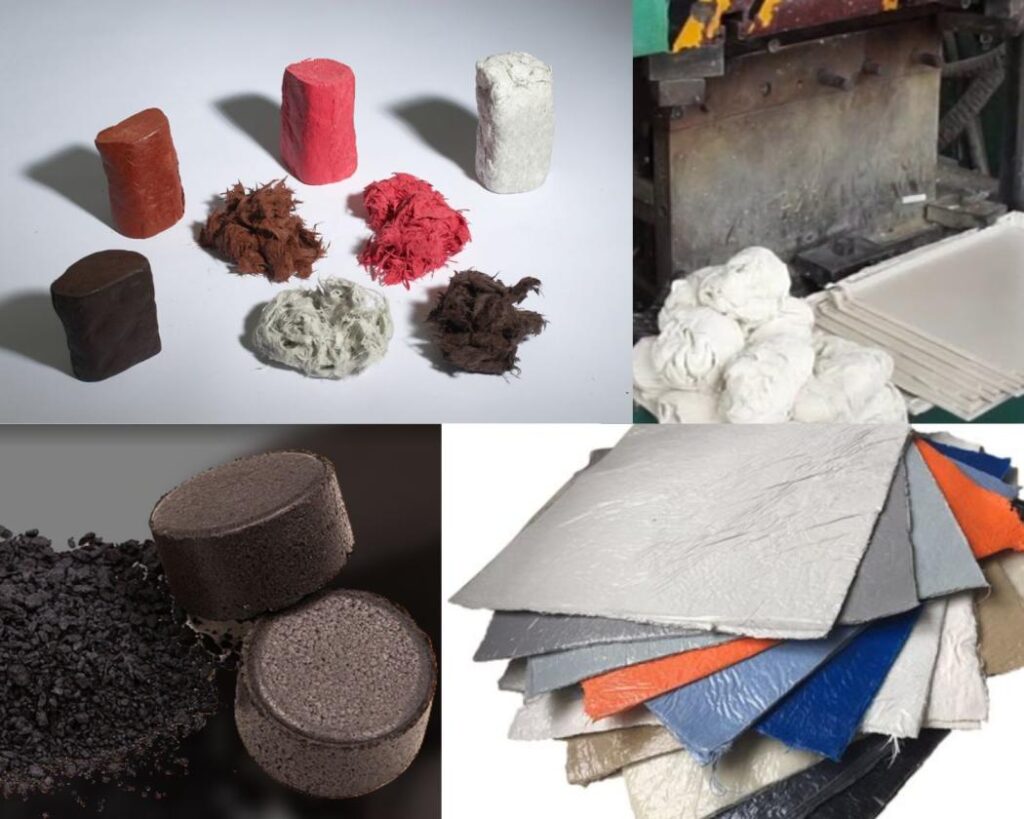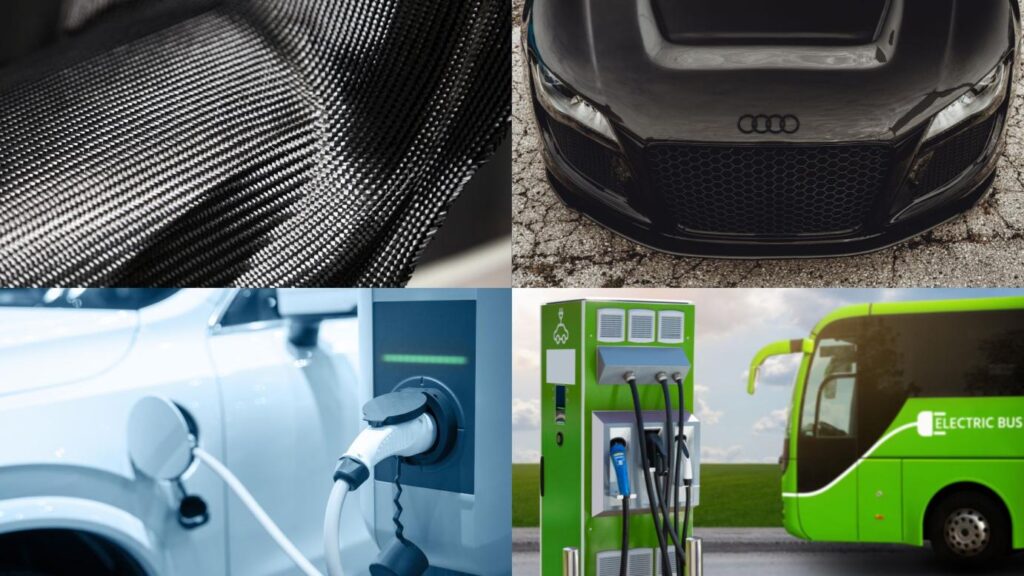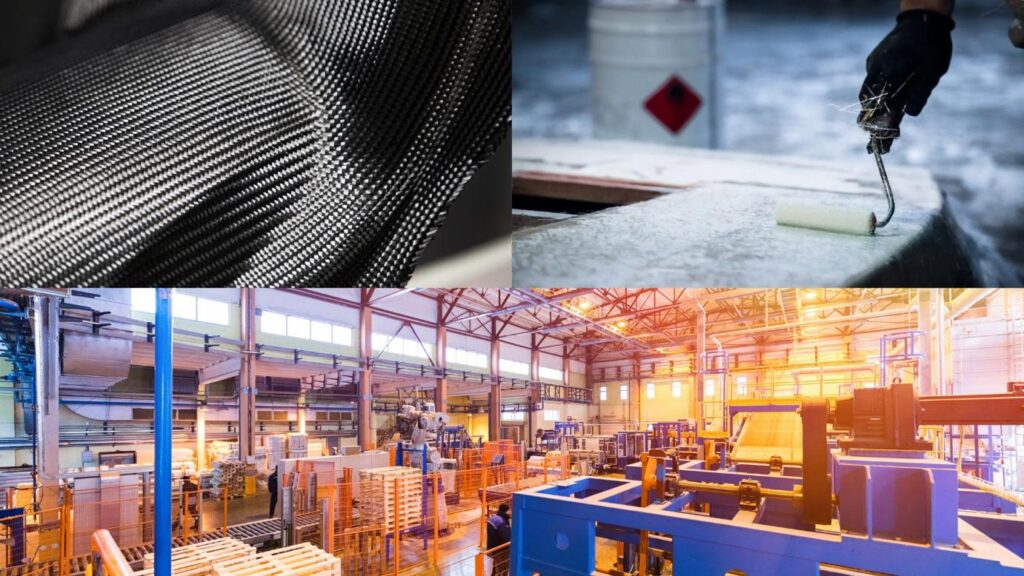Introduction to Bulk Molding Compound
Bulk molding compound (BMC) is a thermoset composite material that is widely used in electrical, electronics, and automotive applications. It consists of an unsaturated polyester resin combined with fillers and fiber reinforcements. BMC offers many beneficial properties at a relatively low cost compared to other engineered plastics.
This article provides an in-depth overview of bulk molding compounds, including:
What is Bulk Molding Compound?
Bulk molding compound (BMC) is made by combining an unsaturated polyester resin with various fillers, additives, and fiber reinforcements. It is supplied as a ready-to-mold putty-like compound in logs or sheet form. BMC is considered a thermoset plastic because it cures irreversibly when heated.
The four main components of bulk molding compound are:
- Resin – Provides the binding matrix to hold the compound together. Unsaturated polyester is by far the most common resin used. It provides useful properties like toughness, stiffness, corrosion resistance, and electrical insulation.
- Reinforcements – Give added mechanical strength and rigidity. Common reinforcements are chopped glass fibers and carbon fibers.
- Fillers – Lower the cost and impart desirable properties like thermal conductivity. Examples are calcium carbonate, silica, clay, and mica.
- Additives – Fine-tune the properties and processing behavior. These include catalysts, inhibitors, pigments, lubricants, and flame retardants.
Curing transforms BMC from a moldable compound into a hardened plastic product. Curing takes place rapidly in a heated mold during the compression or transfer molding process.
Manufacturing Process for BMC
There are four main steps in manufacturing bulk molding compound:
1. Raw Material Preparation
- The various ingredients that make up BMC must be measured out and prepared.
- Unsaturated polyester resin is combined with additives like polymerization inhibitors and pigments.
- Fillers are milled down to the appropriate particle size.
- Glass fibers are chopped to the desired length, typically 1/8 to 1/4 inches.
2. Compounding
- The components are mixed and kneaded together in a compounding extruder or batch mixer.
- This evenly disperses the ingredients and coats the fillers and fibers with resin.
- The compounding process reduces viscosity to aid later molding.
3. Metering
- The properly mixed BMC compound is pumped into logs or extruded into sheets.
- Metering ensures consistent volume and quality.
4. Curing
- Curing transforms the BMC into a solid plastic in the mold through a crosslinking reaction.
- It occurs rapidly with heat and pressure in the molding machine.
- Post-curing may be used after molding to optimize properties.
Applications of Bulk Molding Compounds
BMC is used for electrical, automotive, and general engineering applications including:
- Potting and encapsulation of electronics
- Electrical insulators and connectors
- Terminal blocks for electrical devices
- Relays and coil bobbins
- Switches and sensors
- Motor housings and stators
- Automotive ignition system components
- Lighting components like reflectors
- Small gears, bushings, and bearings
Table 1 summarizes the major applications and typical BMC properties required:
| Application | Typical Properties Needed |
|---|---|
| Electrical insulation | High dielectric strength, arc/tracking resistance |
| Electronic encapsulation | Low CTE, high heat deflection temperature |
| Automotive/engineering | Impact and heat resistance, stiffness |
Benefits and Advantages of Bulk Molding Compounds
Some of the benefits that make BMC composite materials a popular plastic choice include:
- Low cost – BMC can be molded rapidly with short cycle times, leading to economic production. The raw materials are relatively inexpensive.
- Dimensional stability – Very little shrinkage during cure due to the high filler content.
- Excellent electrical properties – High dielectric strength and high resistivity allow use in electronics and electrical insulation.
- Heat resistance – BMC has reasonably good heat deflection and can operate at 120°C continuously. Electrical grades can withstand short-term temperatures over 200°C.
- High mechanical strength – The reinforcing fibers increase flexural strength, stiffness and impact resistance. Tensile strength is more modest.
- Good chemical resistance – Provides protection against automotive fluids, battery acids, alkalis, saline water, and many solvents.
- Wide range of specialized grades – Manufacturers offer grades optimized for arc resistance, weatherability, flame retardance, low shrinkage, and low CTE.
- Ease of coloring – Can be readily pigmented to obtain vibrant, stable colors.
Chemistry and Composition
Bulk molding compound consists of four main components:
Unsaturated Polyester Resin
- Provides the matrix to hold the compound together.
- The most widely used type is orthophthalic polyester. Isophthalic polyester offers better hydrolytic stability.
- The resin contains styrene monomer which copolymerizes during cure to form crosslinks. Styrene level is around 35%.
Reinforcements
- Chopped glass fibers with diameters of 10-15 μm make up 15-25% by weight. Length ranges from 1/8 to 1/4 inches.
- Milled glass fibers, carbon fibers, or mineral fibers can also be used.
- Reinforcements boost mechanical strength and rigidity.
Fillers
- Account for 40-70% of BMC by weight.
- Most common are calcium carbonate, silica, and clay.
- Provide benefits like stiffness, dimensional stability, and thermal conductivity.
Additives
- Added at low levels of less than 5% by weight.
- Include catalysts, mold release agents, flame retardants, pigments, and thixotropic agents.
- Modify curing behavior, viscosity, and properties.
Molding Processes for Bulk Molding Compound
BMC can be molded into parts using:
Compression Molding
- The simplest and most common method.
- BMC is placed in an open, heated mold cavity.
- The material is compressed under high pressure which forces it to flow and fill the cavity completely.
- Compression molding is economical and can mold complex geometries.
Transfer Molding
- BMC is transferred from a chamber using a plunger into closed mold cavities.
- Permits high production rates with very fast cycles.
- Used for high quantity molding of smaller, less complex parts.
Injection Molding
- BMC is heated to reduce viscosity then injected under high pressure into the mold.
- Has excellent repeatability and is very automation friendly.
- Mostly used for larger BMC parts due to higher equipment costs.
Curing Process and Properties
- Curing of bulk molding compound involves crosslinking of the unsaturated polyester chains.
- It occurs rapidly within 1-3 minutes once initiated by heat.
- The main curing reaction is the copolymerization between unsaturated polyester and styrene.
- The degree of cure depends on time, temperature, and catalyst level.
- Fully cured BMC has high stiffness, strength, and thermal stability.
Effect of Cure on Properties
- Cure temperature – Higher temperatures accelerate curing. Excessive temperatures can cause degradation.
- Cure time – Longer times in the mold increase degree of cure.
- Mold pressure – Applied pressure drives off volatiles and densifies the molded part.
- Post-curing – Additional oven curing maximizes crosslinking. Improves electrical and thermal properties.
Testing Methods for BMC Properties
Important BMC properties and associated test methods include:
- Tensile strength – Per ASTM D638
- Flexural strength – ASTM D790 flexural test
- Modulus of elasticity – ASTM D638
- Izod impact strength – ASTM D256
- Heat deflection temperature – ASTM D648
- Coefficient of thermal expansion – ASTM D696
- Flammability – UL 94 vertical burning test
- Water absorption – ASTM D570
- Dielectric strength – ASTM D149
- Arc resistance – ASTM D495
Performance will depend significantly on the specific BMC formulation used. Manufacturers can provide typical property ranges.
Recent Trends and Developments
Some recent trends in bulk molding compound technology include:
- Use of nano-scale reinforcements like nanoclay to further enhance properties.
- Focus on bio-based resins from renewable resources to improve sustainability.
- Low-VOC resins to reduce volatile organic compound emissions.
- Flame-retardant grades meeting UL 94 V-0 for plastic electrical enclosures.
- Low CTE materials for encapsulation of microelectronics.
- High thermal conductivity grades to dissipate heat in electronics.
- Hydrolysis resistant grades for use in high humidity environments.
- Automated transfer molding with closed loop process control.
- Use of 3D printing processes like fused deposition modeling with BMC filament.
Conclusion
In summary, bulk molding compound is an important thermoset composite material used for electrical, electronic, and engineering applications across many industries. It combines useful properties like dielectric strength, dimensional stability, mechanical strength, and heat resistance at a relatively low cost.
BMC’s composition can be tailored by varying the base resin, fillers, reinforcements, and additives to meet specialized requirements. With ongoing technology innovations, bulk molding compounds will continue meeting the demands of modern manufacturing industries.
Manufacturing Process for Bulk Molding Compound
Bulk molding compound (BMC) is manufactured through a series of steps that transforms raw liquid resin, fillers, and fiber reinforcements into a moldable putty-like material. Precise control over the manufacturing process is critical to achieve consistent quality and optimal properties in the final BMC product.
This section provides an in-depth look at the manufacturing steps, equipment, process parameters, and quality control testing involved in producing BMC.
Overview of the BMC Manufacturing Process
These are the four main steps used to manufacture bulk molding compound:
1. Raw Material Preparation
- Importing and preparing the ingredients – resin, fillers, additives, catalysts, inhibitors, fibers
2. Compounding/Mixing
- Blending and kneading the ingredients into a homogeneous compound
3. Metering
- Pumping the BMC compound into logs or sheets
4. Quality Control Testing
- Testing samples to ensure specifications are met
Equipment involved in manufacturing includes mixers, conveyors, extruders, mills, and testing instruments. Precise monitoring and control of process parameters like temperature, pressure, and time is critical during production.
Step 1: Raw Material Preparation
Resin
- The base unsaturated polyester resin is manufactured through esterification and dissolved in styrene monomer.
- Resin properties like reactivity, viscosity, and cure time depend on the type of polyester, styrene content, and additives.
- Small amounts of inhibitors prevent premature curing during storage and transport.
Fillers
- Common fillers used are calcium carbonate, silica, clay, talc, mica, and alumina trihydrate.
- Fillers are milled to obtain the desired particle size and size distribution. Tighter control prevents segregation.
- Surface treatment of fillers improves bonding with the resin matrix.
Fiber Reinforcements
- Glass fibers are made into bundles which are chopped into short lengths of 1/8 to 1/4 inches.
- The sizing coating on glass fibers acts as an interfacial binder with the resin.
- Carbon fibers and mineral fibers can also be used as BMC reinforcements.
Additives
- Additives are incorporated at low levels to modify BMC properties.
- These include cure catalysts, mold release agents, pigments, thixotropic agents, flame retardants, and low shrink additives.
Step 2: Mixing and Compounding
- Intensive mixing blends the ingredients into a homogeneous bulk molding compound.
- It evenly coats the fillers and fibers with resin and reduces viscosity.
- Batch mixers and continuous compounding extruders can be used.
Batch Mixing
- Carried out in high intensity Stirred mixers like planetary mixers or kneaders
- Multiple mixing stages are used, often under vacuum, to fully wet out and disperse components.
- Batch sizes typically range from 55 to 600 lbs.
Continuous Compounding
- Performed in twin screw extruders with multiple mixing zones.
- Provides very high output rates up to 20 tons/hour continuously.
- Tight control over feed rate, screw speed, temperature and residence time.
- Extrudate is cooled through a die to control BMC temperature
Key Process Parameters
- Mixing temperature – Typically 80-120°C. Affects viscosity.
- Mixing time – Longer durations improve dispersion quality.
- Intensity – High shear is needed to break up and evenly distribute fiber bundles.
- Filler content – Higher loading requires more intensive mixing.
Step 3: Metering and Packaging
- The properly compounded BMC material is pumped using a metering system.
- Metering ensures consistent material volume and quality in each log or sheet.
- BMC can be packaged in several forms:
Logs
- Cylindrical logs are most common, typically 8-12″ diameter and up to 5 feet long.
- Logs are wrapped in polyethylene film to prevent styrene evaporation and cured BMC adhesion.
Sheetstock
- BMC is extruded into continuous sheets of various widths and thicknesses.
- Sheets are wrapped in polyethylene and cut to size. Easier to handle than logs.
Bulk Handling
- BMC can be moved in bulk by gravity in large containers or pneumatically pumped.
- Used with automated feed systems in very high volume production.
Step 4: Quality Control Testing
- Samples from each batch are tested to ensure BMC meets specifications.
- Key tests performed:
Viscosity
- Measured using a rotational rheometer. Indicates degree of filler and fiber dispersion.
Specific Gravity
- Checks filler and fiber loading levels.
Reactivity
- Monitored by measuring gel time at different temperatures.
- Indicates cure rate of the BMC.
Mechanical Properties
- Test molded specimens for strength, modulus etc. per ASTM standards.
- Verifies adequate reinforcement and cure.
Appearance
- Visual inspection of color uniformity and surface finish.
Effect of Manufacturing on BMC Properties
- Mixing intensity – Higher intensity improves wetting and dispersion leading to better mechanical properties.
- Filler loading – Increased filler content raises viscosity, improves dimensional stability, and lowers cost. It can reduce strength if mixing is inadequate.
- Fiber length – Longer fibers increase strength, stiffness, and shrinkage. Shorter fibers improve flow.
- Catalyst level – More catalyst reduces cure time but can cause brittleness if moldings cure too rapidly.
- Pigmentation – Heavier pigmentation increases viscosity slightly but allows vibrant, opaque colors.
Recent Advances in BMC Manufacturing
- Automated batching systems – Improves accuracy and flexibility
- Twin screw compounding – Enables high throughputs with tight control
- Real-time monitoring – Sensors provide instant feedback to optimize quality
- Computerized control – Maintains tight tolerances and automatically compensates for variables
- In-line testing – Continuous monitoring rather than lab sampling
- EXTRUCMC – Combines extrusion and molding for rapid production
- Gas-assisted injection molding – Reduces internal stresses in larger parts
Conclusion
In summary, manufacturing high performance and consistent bulk molding compound requires stringent process control from raw material preparation to final QC testing. Key aspects are precise metering of ingredients, intensive mixing to disperse and wet out components, controlled filling, and comprehensive testing. With modern equipment and automation, bulk molding compound can be manufactured to tight specifications at high volumes to suit the needs of diverse industries and applications.
Properties of Bulk Molding Compound
Bulk molding compound (BMC) is engineered to provide a unique combination of properties that make it suitable for electrical, electronic, and structural applications across many industries. Properties can be tailored through the composition, manufacturing process parameters, and curing conditions.
This section provides an overview of the key mechanical, thermal, electrical, and chemical properties exhibited by bulk molding compounds. It also covers testing methods used to characterize BMC materials.
Mechanical Properties
Mechanical properties like strength, stiffness and toughness depend heavily on the filler and fiber reinforcement present in the BMC.
Tensile Properties
- Tensile strength ranges from 8,000 to 15,000 psi per ASTM D638 testing. Elongation at break is under 2%.
- Tensile modulus is typically 0.5 to 4 x 106 psi. BMC is stiff and brittle in tension.
Flexural Properties
- Flexural strength is highest in the fiber direction at 15,000 to 30,000 psi (ASTM D790).
- Flexural modulus ranges from 1 to 5 x 106 psi depending on filler loading.
Compressive Strength
- BMC has good compressive strength of 18,000 to 35,000 psi.
- Compressive properties are less anisotropic than tension or flexure.
Impact Strength
- Izod impact strength per ASTM D256 is on the order of 0.5 to 2 ft-lbs/in.
- Though brittle, impact resistance is boosted by fiber reinforcement.
Thermal Properties
BMC combines reasonable heat resistance with low coefficient of thermal expansion.
Heat Deflection Temperature
- The heat deflection temperature under load is 190-220°F (ASTM D648).
- Allows use for molded parts up to about 120°C continuous service temperature.
Coefficient of Thermal Expansion
- The CTE ranges from 15 to 30 x 10-6 in/in/°F (ASTM D696).
- Low CTE provides good dimensional stability during temperature changes.
Thermal Conductivity
- Thermal conductivity is typically 0.5 to 1.5 W/m-K.
- Can be increased by using fillers like alumina or boron nitride.
Electrical Properties
Excellent dielectric properties make BMC suitable for electrical insulation and electronics encapsulation.
Dielectric Strength
- Dielectric strength ranges from 300 to 500 V/mil (ASTM D149).
- High breakdown voltage allows use in high voltage insulation.
Volume Resistivity
- Volume resistivity is over 1012 ohm-cm (ASTM D257).
- Very low electrical conductivity prevents leakage currents.
Dielectric Constant
- The dielectric constant measured at 1 MHz is between 4 and 6.
- Suitable for high frequency applications like radomes.
Dissipation Factor
- BMC has a dissipation factor of 0.02 to 0.04 at 1 MHz when properly cured.
- Indicates low dielectric losses and high insulation resistance.
Chemical Resistance
BMC offers good resistance to many common automotive and industrial fluids.
- Resists oils, gasoline, battery acid, and aliphatic hydrocarbons.
- Moderate resistance to ketones and alcohols.
- Poor resistance to strong acids and oxidizing agents.
- Affected by prolonged water exposure depending on resin chemistry.
- excellent UV resistance when properly pigmented.
- Paint adhesion is generally good with proper surface preparation.
Factors Affecting BMC Properties
- Filler loading – Increasing filler content raises modulus and hardness but lowers strength.
- Fiber content – More reinforcement boosts strength, stiffness and dimensional stability.
- Cure time/temperature – Higher degree of cure improves strength, heat resistance and electrical properties.
- Molding pressure – Higher pressure increases density and improves surface finish.
- Post-curing – Additional heat curing enhances crosslinking and electrical properties.
- Pigmentation – Adds color but can slightly reduce mechanical properties.
Testing Bulk Molding Compound Properties
Key test methods for BMC characterization include:
- Tensile testing per ASTM D638
- Flexural testing via ASTM D790
- Unnotched Izod impact testing per ASTM D256
- Heat deflection temperature per ASTM D648
- Coefficient of thermal expansion by ASTM D696
- Dielectric breakdown voltage – ASTM D149
- Volume resistivity – ASTM D257
- Flammability – UL 94 vertical burning test
Testing allows quality control during manufacturing and formulation optimization to meet application requirements.
Conclusion
In summary, bulk molding compound offers a unique combination of mechanical strength, dimensional stability, heat resistance, excellent electrical properties, and chemical resistance. With proper composition and process control, BMC can be engineered to satisfy challenging application requirements across diverse industries while retaining excellent moldability and low cost. Extensive testing characterizes the various thermal, mechanical, electrical, and chemical properties guiding effective utilization.
Materials and Composition of Bulk Molding Compound
Bulk molding compound derives its unique performance properties from the specialized ingredients that make up its composition. By selecting and combining the right materials, BMC can be tailored to meet the specific requirements of electrical, electronic, automotive and other engineering applications.
This section provides an overview of the major constituent materials, their roles and properties, and how they interact in bulk molding compounds.
Thermoset Polyester Resin
Unsaturated polyester resin dissolved in styrene provides the continuous phase matrix that binds together the BMC compound after curing.
- Most common is orthophthalic polyester due to low cost. Isophthalic and bisphenol-fumarate resins offer better thermal and hydrolysis resistance.
- The linear polyester chains contain unsaturated bonds that react during cure, forming a 3D network.
- Styrene comprises 35-50% of the resin. It copolymerizes as cure progresses.
- Typical properties include good chemical resistance, mechanical strength, and electrical insulation.
Cure Characteristics
- Polyester cure is initiated by a peroxide catalyst and accelerated by heat.
- The thick, viscous resin converts to a rigid, crosslinked thermoset solid.
- Cure times range from 1 to 3 minutes. Faster cure is better for production but can cause brittleness.
Role in BMC
- Polyester resin provides the continuous phase that bonds all ingredients together.
- Determines processability, cure rate, and basic properties like strength, stiffness and heat resistance.
- Enables electrical insulation, chemical resistance, and low cost.
Fillers
Inert fillers make up 40-70% by weight of BMC formulations. They lower cost, improve dimensional stability, and control shrinkage.
Common Fillers
- Calcium carbonate – Most widely used. Adds stiffness and lowers cost.
- Silica – Amorphous fumed or precipitated grades. Imparts thickening.
- Clay – Kaolin or talc. Provides high aspect ratio for reinforcement.
- Mica – Muscovite or phlogopite mica. Gives electrical insulation and heat conductivity.
Filler Attributes
- Control of particle size and shape is critical – affects flow, surface finish, isotropy.
- Surface treatment improves bonding to resin matrix.
- Low moisture absorption is needed.
- High purity and tight specifications prevent variations.
Role in BMC
- Fillers reduce mold shrinkage and warpage due to their low CTE.
- Impart dimensional stability, heat resistance, and stiffness.
- Enhance thermal conductivity to dissipate heat in electronics.
- Lower material cost significantly.
- Can comprise over 70% of BMC by weight.
Fiber Reinforcements
Discontinuous fibers provide mechanical reinforcement and improve strength, stiffness, and shrinkage control.
Glass Fibers
- Most common reinforcement at 15-25% by weight.
- Made of E-glass with 10-15 μm diameter filaments.
- Chopped into short lengths from 1/8 to 1/4 inches long.
- Sizing coating improves bonding to resin matrix.
Carbon Fibers
- Higher strength and modulus than glass (but 10x the cost).
- Used at lower levels of 5-15% by weight of BMC.
- Short 3-6 mm lengths are preferred for dispersion.
Other Fibers
- Mineral fibers – higher temperature resistance
- Natural fibers – for sustainability
- Hybrid fiber mixes – optimize cost and performance
Role in BMC
- Boosts flexural strength, modulus, and impact resistance
- Provides fracture toughness to the brittle resin matrix
- Reduces shrinkage due to the reinforcement mechanism
- Short random fibers give more isotropic properties
Additives
Various chemical additives are incorporated in small quantities to modify BMC properties as needed.
Curing Additives
- Peroxide initiators – Kicks off decomposition, generating free radicals to begin cure
- Promoters – usually tertiary amines. Accelerates the cure reaction kinetics.
- Inhibitors – Prevent premature reaction and extend shelf life
Property Enhancers
- Flame retardants – usually halogenated additives or alumina trihydrate
- Low shrink additives – typically thermoplastic polymers
- Antioxidants – improve weathering resistance
- Mold release agents – allows easy demolding
- Thixotropic agents – provides shear thinning for good flow/mold fill
- Pigments – titanium dioxide or carbon black for color
- Low VOC resins – 100% styrene-free versions for lower emissions
Role in BMC
- Enable tailoring of cure rate, shrinkage, flammability, viscosity, weatherability and aesthetics
- Impart critical functionality needed for end use applications
- Modify flow, demolding, surface finish
- Small quantities have a big effect by targeting specific properties
Interactions Between Ingredients
- The resin phase wets out and binds to the filler and fiber surfaces. Good adhesion is critical.
- Reinforcements strengthen and stiffen the composite through stress transfer to the fibers.
- Fillers disrupt the continuity of the resin phase, improving heat resistance.
- Cure reaction kinetics are influenced by ingredients through steric effects and viscosity changes.
- Additives preferentially migrate to the interface and modify fiber-matrix bonding.
- Components and morphology determine isotropy, failure mode, and anisotropy.
Conclusion
The composition of bulk molding compound has a major effect on its performance, processability and cost effectiveness. Polyester resin provides basic polymer properties and enables cure to a thermoset. Discontinuous fiber reinforcement imparts strength and rigidity. Inert mineral fillers enhance dimensional stability, thermal conductivity and lower cost. Small levels of additives impart specialized functionality like flame retardance. Interactions between the ingredients enable tailoring BMC to meet diverse application requirements.
Applications of Bulk Molding Compound
Bulk molding compound (BMC) is used across a diverse range of industries and applications due to its favorable electrical properties, heat resistance, mechanical strength, and low cost. Major application areas include electrical insulation, automotive components, electronics encapsulation, and engineering/structural parts.
This section provides an overview of the common applications for bulk molding compound and the associated properties needed.
Electrical Insulation
The excellent dielectric properties and arc/tracking resistance of BMC make it ideal for insulation of high voltage electrical devices.
Typical applications:
- Transformer coil bobbins and inter-winding insulation
- Motor end caps and armatures
- Switchgear components
- Bus bar insulation
- High voltage insulators
- Ignition components
Key properties needed:
- High dielectric strength and low loss factor
- Excellent tracking/erosion resistance
- Low moisture absorption
- Good mechanical strength
- Dimensional stability
- Heat and flame resistance
Automotive Components
BMC’s combination of strength, dimensional stability, and moldability suit it for many automotive applications.
Typical applications:
- Distributor caps
- Ignition system components
- Fuse boxes
- Lighting reflectors
- Connectors and relay blocks
- Small gears, pulleys, and bushings
- Mirror housing and mounts
- Structural support brackets
Key properties needed:
- Heat, gasoline, and oil resistance
- Impact strength and toughness
- Good dimensional tolerance
- Short molding cycles
- Consistent quality
Electronics Encapsulation
BMC’s electrical insulation properties and heat resistance allow protecting sensitive electronics.
Applications include:
- Encapsulation of power supplies and AC/DC converters
- Potting of integrated circuits
- Housings for capacitors, relays, and EMI/RFI shielding
- Semiconductor packaging and sealing against moisture
- High voltage insulators for consumer electronics
Key properties needed:
- Low coefficient of thermal expansion
- High thermal conductivity
- Low shrinkage on cure
- Excellent dielectric strength over wide temperature range
- Good adhesion to various substrates
Engineering and Structural Components
BMC’s strength, rigidity, and moldability make it suitable for diverse industrial applications.
Typical uses:
- Gears, bushings, and small mechanical parts
- Material handling equipment components
- Electrical breaker parts like toggles
- Pump housings, impellers, valves
- Business machine parts like gears
- Appliance components
- Sporting goods
- Composites with foam or wood fiber
Key properties needed:
- High tensile and flexural modulus
- Good dimensional stability
- Excellent filler-resin adhesion
- Fast molding cycles
- Consistency for high volume production
Other Applications
Several additional specialty uses exist:
Transportation – Railroad cross ties, truck panels, vehicle armor
Construction – Wall panels, electrical boxes, conduit, simulated granite/marble
Marine – Boat hulls, dock floats, buoys
Renewable Energy – Wind turbine blades, solar panel frames
Selecting BMC Grades
With over 100 specialized formulations, manufacturers offer grades optimized for:
- Electrical insulation
- Arc/tracking resistance
- Low smoke/flame retardance
- Weathering/UV resistance
- Low shrinkage
- Heat deflection resistance
- Corrosion resistance
- Low CTE for microelectronics
Proper grade selection ensures BMC meets the critical performance needs of the application.
Conclusion
In summary, bulk molding compound is used in a wide array of electrical, electronic, automotive, and engineering applications that leverage its favorable electrical properties, structural rigidity, and processability. Grades can be tailored to meet stringent application requirements through the composition and manufacturing process. BMC’s unique combination of performance, ease of molding, and low cost will ensure its continued utilization across many industries.
Benefits and Advantages of Bulk Molding Compound
Bulk molding compound (BMC) offers numerous benefits that make it a popular choice for electrical, electronic, and engineering applications across many industries. BMC combines useful properties like high dielectric strength, dimensional stability, mechanical strength, and heat resistance while retaining excellent moldability and low cost.
This section highlights the key benefits and advantages of BMC materials and processing.
Electrical Insulation Properties
- Excellent dielectric strength of 300-500 V/mil allows use in high voltage insulation up to 15kV.
- High resistivity over 1012 ohm-cm prevents current leakage.
- Low dissipation factor below 0.04 gives high insulation resistance.
- Very low moisture absorption maintains electrical properties.
- Good arc/tracking resistance prevents carbon tracking failures.
Mechanical Properties
- Tensile strength of 8,000-15,000 psi provides structural rigidity.
- Flexural strength above 15,000 psi makes BMC suitable for load-bearing components.
- Modulus of elasticity ranges from 0.5 to 5 million psi for stiffness.
- Reinforcing fibers increase toughness and impact strength.
Thermal Properties
- Heat deflection temperature of 190-220°F allows continuous use to 120°C.
- Coefficient of thermal expansion is low, from 15-30 x 10-6 in/in/°F, giving dimensional stability.
- Does not require drying prior to molding unlike many other resins.
Physical Properties
- High filler content minimizes mold shrinkage for precision tolerances.
- Low shrinkage also minimizes internal stresses and warpage.
- Excellent surface finish attainable with proper mold design.
Chemical Resistance
- Resists weak acids, alkalis, oils, greases, aliphatic hydrocarbons.
- Good UV stability when properly pigmented.
- Paints and adhesives bond well for decorating/joining.
Processing Advantages
- Rapid cure times of 1-3 minutes allow high production rates.
- Easily pigmented to obtain bright, resilient colors.
- Low molding pressure requirements versus other composites.
- Adaptable to automated production with good process control.
- Low VOC emissions with styrene-free and low-styrene resins.
Cost Factors
- Lower material cost than engineering plastics like nylon or PPS.
- Short molding cycles increase output and lower part cost.
- Excellent flow allows faster cavitation of molds for high volume production.
- Lower waste versus thermoset sheet molding compound.
- Low tooling cost compared to injection or compression molding.
Performance Enhancements
- Flame-retardant, low-smoke, and UL 94 V-0 grades available.
- Low CTE versions for microelectronics encapsulation.
- High thermal conductivity formulations to dissipate heat.
- Hydrolysis resistant grades for wet environments.
Conclusion
In summary, bulk molding compound offers an exceptional combination of beneficial properties, processing advantages, and cost savings that make it a popular material across many industries. It provides unique advantages including dimensional stability, heat resistance, strength, electrical insulation, short molding cycles, and low cost. With ongoing advances in materials and process engineering, BMC will continue meeting the stringent requirements of the most demanding applications.
Recent Trends and Developments in Bulk Molding Compound
Bulk molding compound (BMC) technology continues advancing in terms of both materials and manufacturing processes. Compounders are developing innovative new formulations targeting improved performance, sustainability, and production efficiency.
This section highlights recent trends and developments that are shaping the future landscape of bulk molding compounds.
Material Innovations
New BMC materials are addressing evolving needs in diverse application areas:
Nanocomposites
- Incorporation of nano-scale reinforcements like organoclays, carbon nanotubes, and graphene.
- Improves dimensional stability, strength, electrical properties.
- Allows down gauging and weight reduction.
Bio-based Resins
- Unsaturated polyesters derived from renewable resources such as plant oils.
- Offers sustainability with comparable performance.
- Soybean, canola, and vegetable oils are common feedstocks.
Low VOC Resins
- Reduction or elimination of styrene content to lower VOC emissions.
- Maintains fast cure response using reactive diluents.
- Improves manufacturing work environment.
Flame Retardant Grades
- Halogen-free formulations meeting UL 94 V-0 flammability standard.
- Based on phosphorus additives, mineral fillers like ATH.
- Needed for plastic electrical enclosures and connectors.
High Thermal Conductivity
- Specialized thermally conductive BMCs using ceramic or carbon fillers.
- Enables thermal management of high power electronics and LEDs.
- Thermal conductivity up to 4 W/m-K.
Hydrolysis Resistance
- For use in high temperature, high humidity environments.
- Polyester resins based on isophthalic acid have greater hydrolytic stability.
Manufacturing Innovations
Advances in BMC manufacturing technology include:
Automated Transfer Molding
- Complete computerized control of transfer presses for precision, repeatability, quality assurance.
- Real-time monitoring of temperature, pressure, position, time.
- Allows rapid changeover between molds.
Compression Molding Automation
- Automated material handling, mold loading and unloading.
- Process monitoring with feedback loop control.
- Robotic demolding and trimming.
Microcellular Foaming
- Reaction injection molding using physical blowing agents.
- Creates ultra-low density BMC foam.
- Provides weight savings, improved acoustics, better flow.
3D Printing
- Fused deposition modeling (FDM) of BMC using extruded filament feedstock.
- Allows complex geometries not easily molded.
- Complementary to conventional molding processes.
In-Mold Assembly
- Multi-shot molding, co-molding BMC with thermoplastics.
- Insert molding of metal components.
- Replaces post-mold assembly.
Market Outlook
Several factors are driving increasing BMC utilization:
- Automotive lightweighting using BMC to replace metals.
- Growth in EV/HEV vehicles needing electrical insulation.
- Increasing use of electronics in vehicles, appliances, industrial equipment.
- LED lighting components such as heat sinks.
- Renewable energy industry – wind turbines, solar panel frames.
- Smart grid infrastructure builds out needing insulators.
- 5G networks requiring electrical and EMI shielding.
Conclusion
Recent years have seen considerable innovation in both BMC materials and manufacturing processes. Trends like nanocomposites, bio-resins, 3D printing, and automated molding will expand applications for bulk molding compounds across many industries. With its unique cost/performance ratio, BMC is poised for continued growth as sustainable and high performance engineered materials receive greater emphasis.
Conclusion
Bulk molding compound has become an increasingly important engineered composite material used across diverse industries. It offers an exceptional balance of functional properties, processing ease, and cost effectiveness. With ongoing advances, BMC will continue meeting the stringent requirements of electrical, electronic, automotive, and structural applications.
This article has provided a comprehensive overview of bulk molding compounds encompassing:
- Definition – Thermoset composite of polyester resin reinforced with glass fibers and mineral fillers
- Manufacturing process – Mixing, compounding, metering into logs/sheets
- Properties – Dimensional stability, strength, stiffness, electrical insulation
- Composition – Polyester resin, glass fibers, mineral fillers, additives
- Applications – Electrical insulation, automotive parts, electronics encapsulation
- Benefits – Excellent dielectric properties, low cost, short mold cycles
- Trends – Bio-resins, nanocomposites, 3D printing, automated molding
Key Takeaways
Some of the essential points covered include:
- Bulk molding compound offers a unique combination of electrical, mechanical, and thermal properties.
- Composite composition provides tunable performance and cost via fibers, fillers and additives.
- Rapid cure enables short, cost-effective molding cycles.
- Dimensional stability and strength allow replacing metals.
- BMC serves critical needs in insulation, electronics, automotive, and diverse engineering uses.
- Innovations are expanding BMC into new applications and industries.
Critical Properties for Success
For quality, consistency, and performance, BMC requires:
- Stringent process control during manufacturing.
- Optimized mixing to disperse and wet out ingredients.
- Balancing filler and fiber loading for desired properties.
- Matching cure cycles to resin reactivity.
- Minimizing voids and defects through proper mold design.
- Verification testing to ensure specifications are met.
Future Outlook
Bulk molding compound will benefit from multiple trends:
- Lightweighting in automotive and aerospace sectors to improve fuel efficiency.
- Growth of EV/HEV vehicles needing electrical insulation and thermal management.
- Increasing electronics content in consumer products to enable smart functionality.
- Renewable energy including wind turbines, batteries, power electronics.
- High speed 5G networks requiring electrical and EMI shielding.
- Sustainability pressures driving bio-resins, recycled composites, low emissions manufacturing.
Concluding Remarks
In conclusion, bulk molding compound possesses an exceptional combination of properties that make it suitable for numerous demanding applications across diverse industries. With ongoing material and process developments, BMC will continue penetrating new markets and meeting evolving needs. Its unique cost/performance ratio ensures BMC will remain an essential composite material technology.
Here is a FAQ section on bulk molding compound with 12 popular questions:
Frequently Asked Questions
Below are answers to 12 common questions about bulk molding compound (BMC).
What is bulk molding compound?
Bulk molding compound is a thermoset composite made of:
- Unsaturated polyester resin dissolved in styrene monomer
- Reinforcements like short glass fibers
- Fillers such as calcium carbonate, mica, clay
- Additives including cure catalysts, release agents, pigments
It cures rapidly when heated to form a rigid, crosslinked material.
What are the main properties of BMC?
- High dielectric strength for electrical insulation
- Good mechanical strength and rigidity
- Excellent dimensional stability and low shrinkage
- High heat deflection temperature around 220°F
- Good resistance to chemicals, gasoline, oils
- Low coefficient of thermal expansion
- Heat conductive versions available
- Flame retardant grades meeting UL 94 V-0
What is BMC used for?
Major applications include:
- Electrical insulation – ignitions, motors, transformers
- Electronics encapsulation – semiconductors, capacitors
- Automotive parts – distributor caps, headlight reflectors
- Engineering components – gears, connectors, structural parts
BMC suits many electrical, electronic, automotive, and industrial needs.
What are the advantages of BMC?
Benefits of BMC:
- Excellent dielectric properties for insulation
- Good mechanical strength and toughness
- Low thermal expansion for dimensional stability
- Short molding cycles for cost efficiency
- Easily pigmented to achieve bright, resilient colors
- Low emission and 100% styrene-free versions available
- Flame retardant grades meet strict safety standards
- Far lower cost than many engineered plastics
How is BMC manufactured?
BMC manufacturing involves:
- Raw material preparation – polyester resin, fibers, fillers, additives
- Compounding – intensive mixing and kneading
- Metering – pumping into logs or sheets
- Quality testing – sample analysis to verify specifications
Advanced manufacturing uses real-time monitoring and computer control.
How is BMC molded into parts?
Main molding methods:
- Compression molding – heating BMC in an open mold under high pressure
- Transfer molding – forcing BMC from a chamber into closed mold cavities
- Injection molding – heating then injecting BMC using a screw
Molding cures and shapes the BMC into final products.
What equipment is used to mold BMC?
- Compression presses – hydraulic or electro-mechanical
- Transfer presses – plunger, screw feed, or ram injection
- BMC injection molding machines – specially adapted machines
- Metal molds – typically high strength tool steel with machined cavities
What determines the properties of BMC?
Key factors influencing BMC properties:
- Fiber content – Higher loading increases strength and modulus
- Filler content – More filler raises heat deflection temperature
- Cure conditions – Time, temperature, and pressure affect degree of cure
- Resin chemistry – Determines baseline properties
- Additives – Tailor flame resistance, electrical properties, color, etc.
What are recent trends with BMC?
Some recent BMC trends:
- Nanocomposites using nano-clays or carbon nanotubes
- Bioresins derived from renewable feedstocks like plant oils
- Flame retardant grades meeting UL 94 V-0 standard
- Low CTE materials for electronics encapsulation
- Automated transfer molding with closed-loop process control
What testing is done on BMC?
Key BMC tests per ASTM standards:
- Dielectric breakdown voltage
- Tensile and flexural strength
- Heat deflection temperature
- Coefficient of thermal expansion
- Flammability rating such as UL 94 V-0
Testing verifies specifications are met.
What is the future outlook for BMC?
Growth opportunities from trends like:
- Lightweighting in automotive and aerospace
- Electric vehicles needing insulation and thermal management
- LED lighting components such as heat sinks
- Electronics in consumer products
- Renewable energy – wind turbines, solar panels
BMC benefits from increased use of electronics across industries.
Where can I find more information on BMC?
- BMC suppliers such as IDI, A. Schulman, and Continental Structural Plastics
- Trade organizations like the Composite Materials Handbook
- Published journal articles on BMC molding, properties, and applications
- Patents covering BMC compositions, additives, and manufacturing processes









